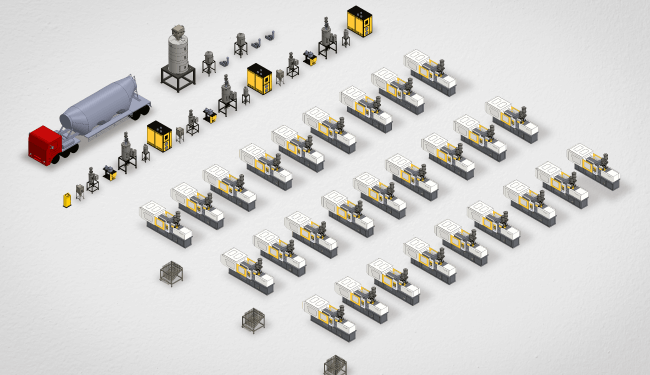Understand the advantages and disadvantages of central material conveying systems, which are crucial for many production and material handling processes. These systems, available in various shapes and sizes, safely and efficiently transport materials from one area to another. By using a central material conveying system properly, you can improve the speed, safety, and efficiency of materials handling, as well as reduce production costs.
However, there are also a few disadvantages that you should consider before deciding to use one. In this article, we’ll explore the advantages and disadvantages of central material conveying systems and offer tips for getting the most out of them.
What is a Central Material Conveying System?
A central material conveying system is a type of bulk material handling system that facilitates the transportation of large numbers of items from one area to the next. This system, which is often utilized in factories and warehouses, typically includes a sequence of conveyor belts or other moving parts that are connected to a central controller. The controller coordinates the speed and direction of the unit, ensuring materials are moved swiftly and easily between different areas.
Advantages of Central Material Conveying Systems
It is possible to decrease or eliminate the need to handle materials manually in a manufacturing or production facility by using a central material conveying system. One of its most obvious benefits is that it can help reduce or eliminate the need for manual handling of materials. This can improve employee safety as well as increase productivity.
Furthermore, it can improve material flow within the facility. By having a central point for material conveyance, it becomes easier to control and direct the flow of materials where they need to go. Lastly, central material conveying systems can also help to improve cleanliness and organization within a facility.
All materials can be conveyed through one central system, making it easier to maintain cleanliness and organization. Employees will have a better working environment and quality control will improve as a result.
Disadvantages of Central Material Conveying Systems
Before investing in a central material conveying system for your business, you should be aware of the various disadvantages of these systems. The most notable disadvantage is the high initial cost of installation. Central material conveying systems also require regular maintenance and upkeep to operate effectively.
Proper maintenance is important for the proper functioning of central material conveying systems. If they are not properly maintained, they can become clogged or damaged and cause significant downtime and lost productivity. Furthermore, these systems may not be suitable for businesses that have high levels of fluctuating production demands, as the system must be appropriately sized to meet those demands.
Types of Central Material Conveying Systems
There are a few different types of central material conveying systems to choose from, including belt conveyors, screw conveyors, pneumatic conveyors, and vibrating conveyors. A belt conveyor transports materials using a continuous belt, a screw conveyor moves materials with a rotating screw, a pneumatic conveyor uses air pressure to transport materials through tubes, and a vibrating conveyor moves materials using vibration along a surface.
- Centralized material conveying systems are classified based on the types of materials they are capable of handling.
- Bulk materials: These systems are specifically designed for handling large volumes of dry materials like coal, gravel, and wood chips. They often include conveyor belts, augers, and bucket elevators.
- Unit load materials: These systems are designed for handling smaller volumes of homogenous products like boxes, bottles, and cans. They frequently include chain or roller conveyors.
- Centralized material conveying systems have several benefits compared to decentralized systems:
- Increased efficiency: Centralized conveying can reduce overall equipment and labor costs by consolidating material handling into a single system.
- Improved flexibility: Centralized systems can be easily reconfigured to adapt to changes in production volume or product mix.
- Enhanced safety: Centralized conveying can help reduce the risk of injuries by eliminating the need for manual handling of materials.
Common Applications of Central Material Conveying Systems
A central material conveying system can be an effective way to move materials within a factory, warehouse, or other industrial facilities. There are various types of these systems, each with its benefits and drawbacks. Some common applications for these systems include:
- Transporting materials within the facility from one location to another.
- Facilitating the transfer of materials between different machines.
- Consolidating materials in a central storage location.
The different requirements of these applications mean it is important to select the appropriate type of system for your needs. If you are uncertain about which system is best for you, it is advisable to consult with a professional before making a purchase.
Benefits of Central Material Conveying Systems in Your Business
There are several advantages to implementing a central material conveying system in your business. One of the most notable benefits is the reduction in labor needed to move materials from one location to another. Instead of multiple employees manually transporting materials around the facility, a central conveying system can do the work with little operator involvement.
Implementing a central material conveying system can not only lower labor costs but also improve safety within your facility. By automating the movement of materials and eliminating the need for manual handling of heavy or awkward loads, you can reduce the risk of workplace injuries and keep employees organized and focused. By implementing a central material conveying system, you can improve the overall efficiency of your operation.
This system reduces the time and effort needed to move materials, freeing up your employees to focus on tasks that contribute to the bottom line. Additionally, a well-designed conveying system minimizes downtime caused by material handling issues.
When is the Best Time to Use a Central Material Conveying System?
Mechanical systems called central material conveying systems move materials from one point to another within a facility. It is important to consider the advantages and disadvantages of using this system before deciding when it is the best choice.
- A central material conveying system can improve the efficiency of your operations by reducing the time needed to move materials and minimizing wear and tear on equipment. These benefits can free up time for other tasks and smooth the movement of materials.
- A central material conveying system can also improve safety in your facility by keeping materials away from potential hazards and segregating different types of materials to prevent accidents. This system can protect areas near forklifts or other moving machinery and reduce the risk of mixing materials.
- One potential disadvantage of a central material conveying system is the high upfront cost of purchasing and installing the system. Before making this investment, you should carefully consider whether the system will be beneficial for your operations. You should also be prepared for the ongoing cost of regular maintenance and repairs.
Conclusion
Central material conveying systems have many benefits compared to manual methods, including reduced labor costs, increased productivity, and improved accuracy in handling materials. However, they may also be challenging to install and require significant maintenance. To make the best decision for your needs, it is important to consider both the advantages and disadvantages of this technology and evaluate other automation solutions available.





Discussion about this post